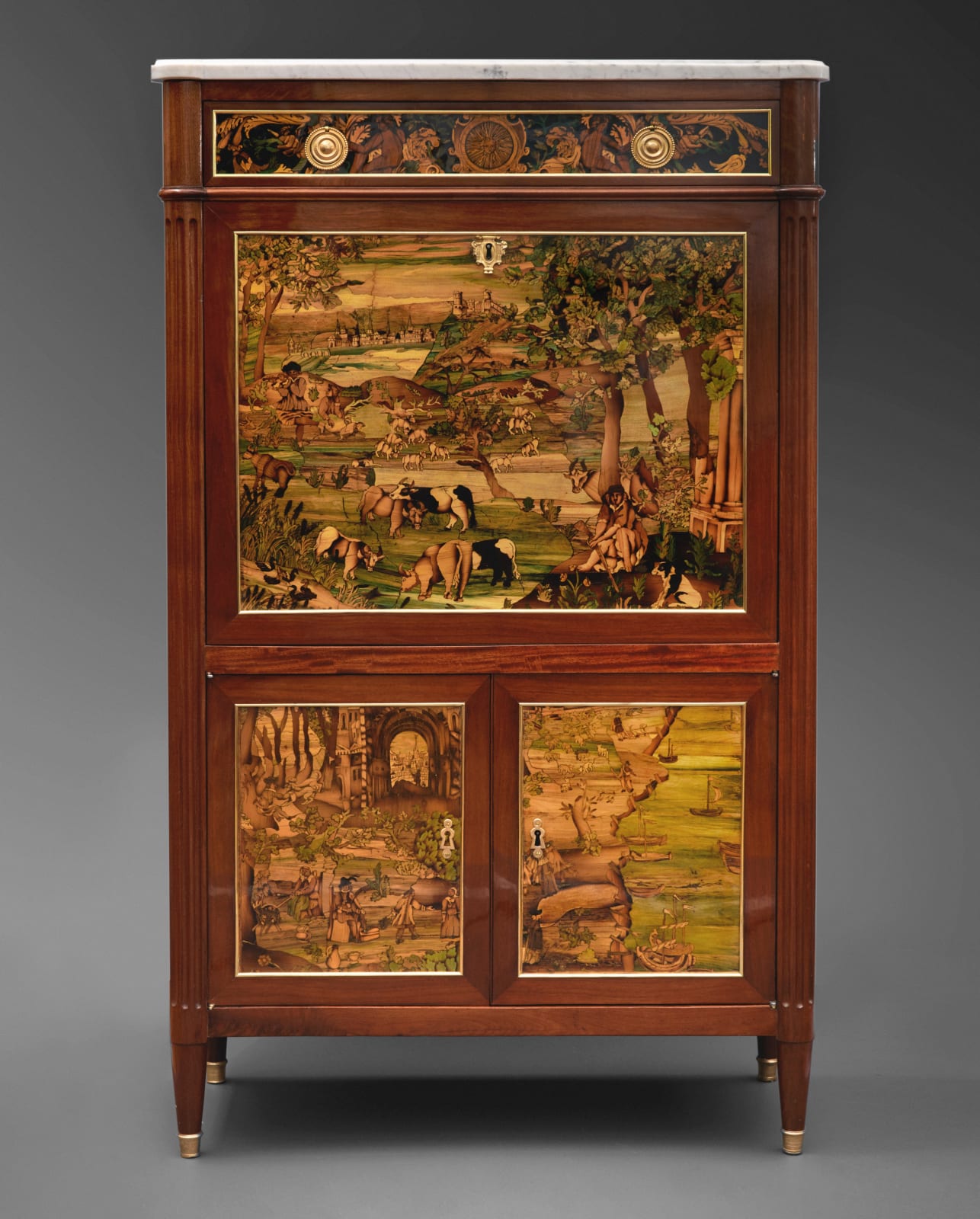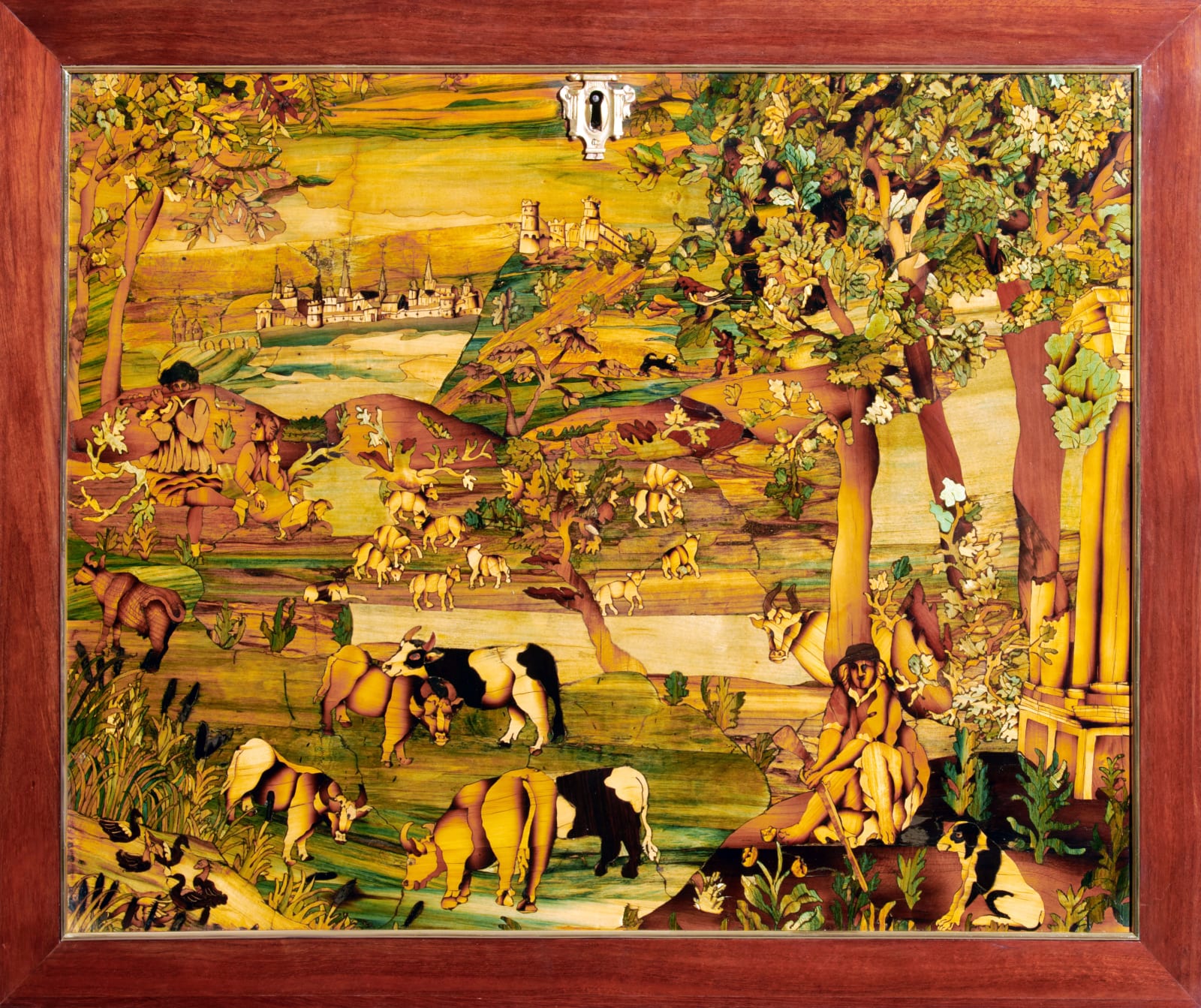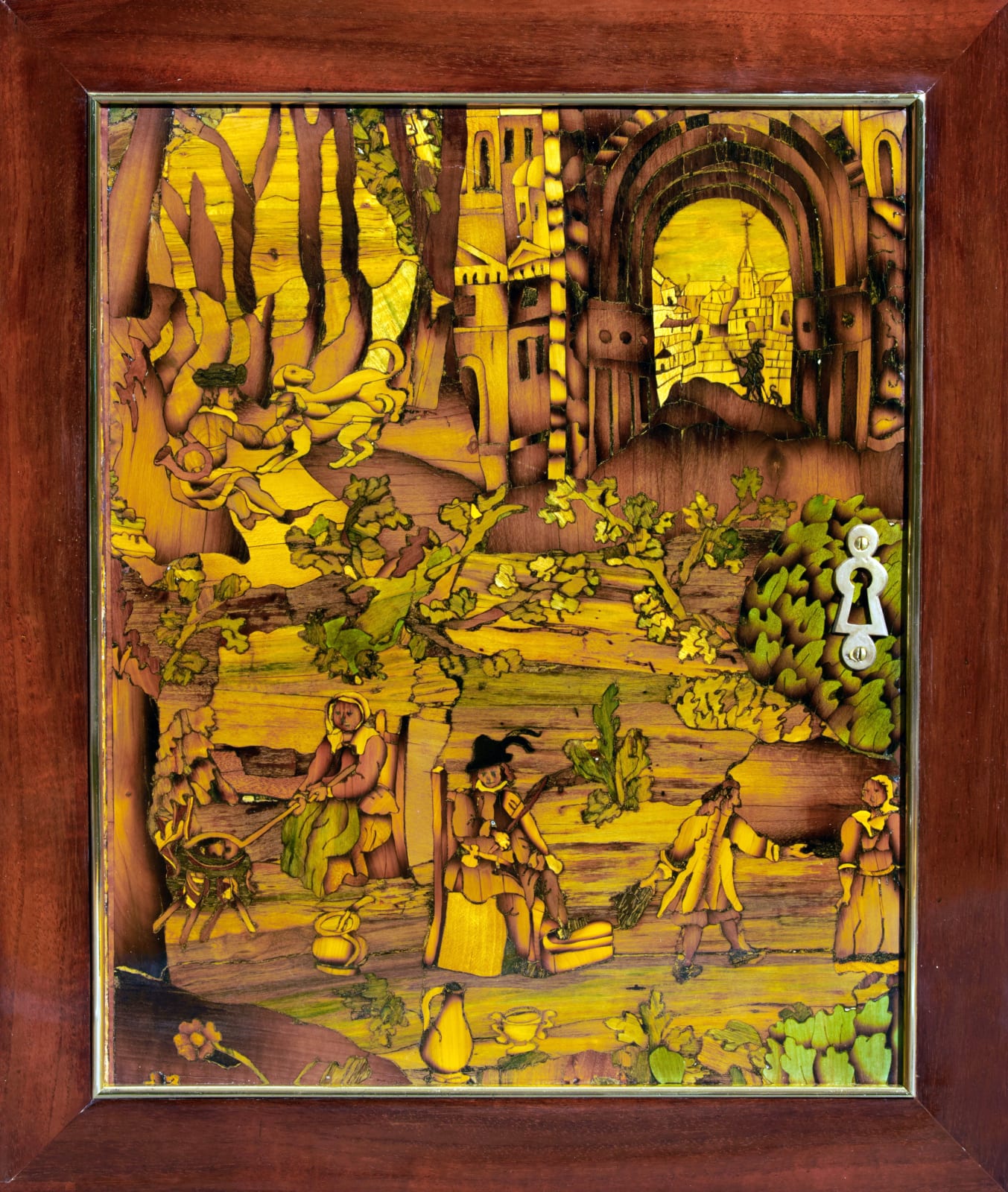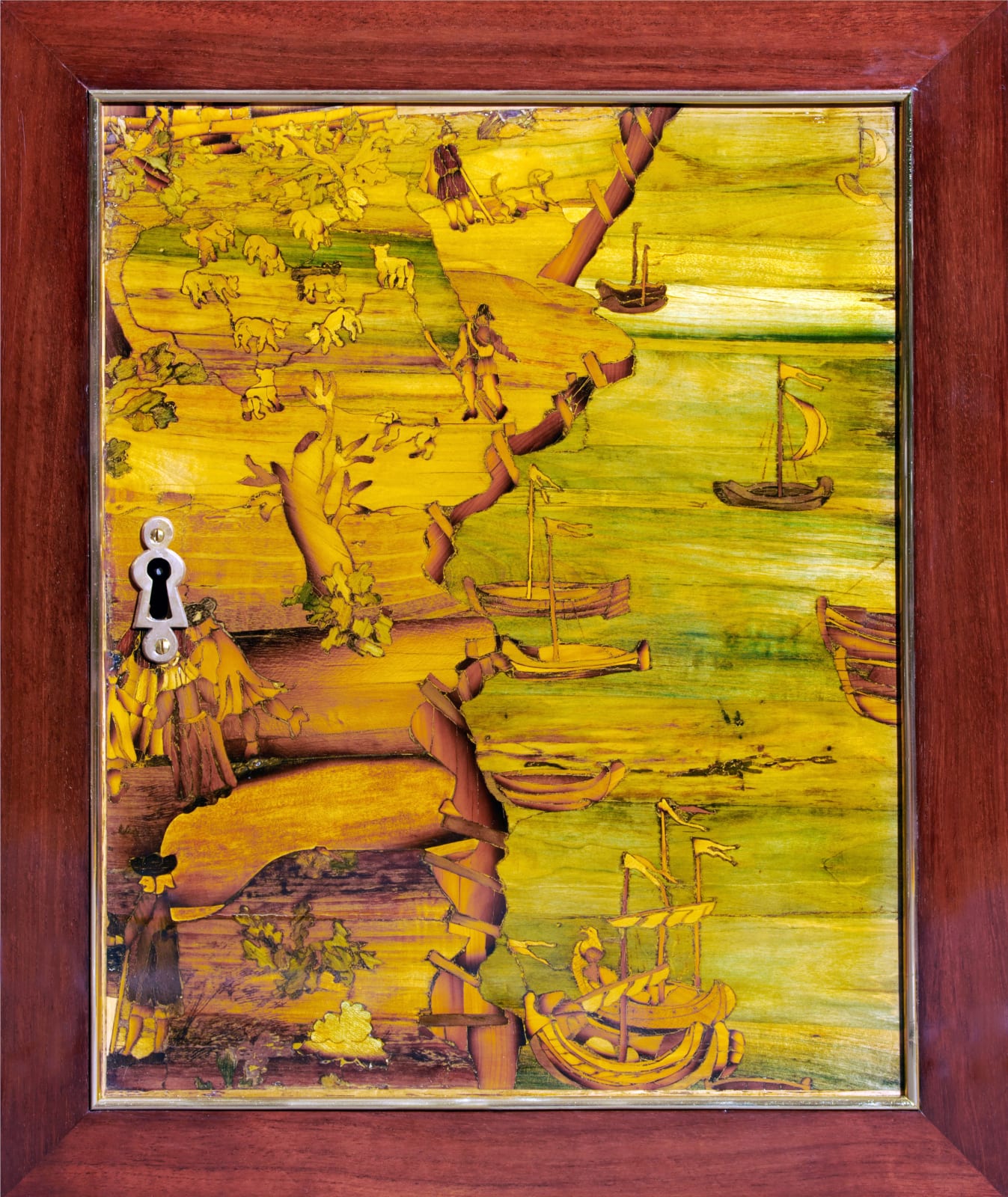Unknown
Further images
Provenance
Château de Saint-Leu.
An important and very rare Louis XVI mahogany secrétaire à abattant with late sixteenth or early seventeenth century inset pear, apple and other fruitwood marquetry panels showing architectural, figural, sea and landscape views, most probably originating from south Germany and in particular Augsburg. The secrétaire stamped on the back of the oak carcass frame with the mark of Château de Saint-Leu comprising a crown above the letters S.L within an oval border. Of rectangular form with a white marble top above a frieze drawer with an inset marquetry panel comprising a central radiating sun within a cartouche flanked by figures and foliage, with a pair of circular beaded ring-pull handles, the frieze above a fall-front door with an inset marquetry panel portraying a magnificent topographical panorama with cattle and sheep, trees, classical ruins and figures in the foreground with hills and fields behind and in the distance a fortified town with numerous churches, steeples and a hill top castle. The fall-front with a Neo-classical escutcheon at the top, opening to reveal a gilt tooled green-leather writing slide in front of a lower open compartment flanked on either side by three small drawers, each with a circular ring-pull handle and two open shelves above. The fall-front above two lower doors, each with inset marquetry panels, the one to the left showing in the foreground a woman cooking over a fire, a man seated and a couple to the right, with trees and foliage above and to the upper left a huntsman with his hounds and to the upper right an elaborate architectural archway through which can be seen a man and his dog in front of a town with a church. The right hand panel showing a coastal scene with numerous sailing vessels in the sea occupying the right hand side and on the land to the left, figures standing and merry making and above a shepherd and his sheep. The whole flanked by fluted pilasters on toupie feet. Cleaned and in restored condition, the white marble top replaced and writing slide partly replaced.
Paris, circa 1780
Height 143 cm, width 86 cm, depth 37 cm.
This magnificent secrétaire à abattant is not only a highly unusual piece but comes with an important provenance since it is stamped with the mark of Château de Saint-Leu in the Oise valley. The mahogany veneered oak carcass frame typifies the clean architectural Neo-classical lines of the late Louis XVI period, comparing for instance in form with another secrétaire by Jacques Laurent Cosson (1737-1812), illustrated in Pierre Kjellberg, “Le Mobilier Français du XVIIIe Siècle”, 1998, p. 188. Although a wide variety of French eighteenth century pieces of furniture were ornamented with earlier and sometimes foreign-made marquetry or lacquered panels, the use of the present type of marquetry panels on a Neo-classical piece was highly unusual. This would suggest that this work was made as a special commission, perhaps to the order of a marchand-mercier or the Garde-Meuble who instructed the ébéniste to incorporate panels from an entirely different work of art.
The style of the marquetry, using fruitwoods such as pear and apple as well as the figural images in combination with the architectural detailing to include ruins, tightly knit buildings, archways and steeples compares closely with marquetry made in south Germany and in particular at Augsburg during the late sixteenth and early seventeenth centuries. For instance similar complex marquetry panels were used to adorn the so called Wrangel cabinet, made in Augsburg 1566, now in the Westfälisches Landesmuseum für Kunst und Kulturgeschichte Münster as well as a cabinet from the Steinitz Collection (sold Christie’s London, 6th December 2007, lot 362) and furthermore a table cabinet, probably made in Augsburg in the late sixteenth century (the Forbeses of Pitsligo and the Marquesses of Lothian Collections sale, Sotheby’s 28th March 2017, lot 462).
From the mid sixteenth century Augsburg rapidly rose as an important centre of furniture making for the international market. In particular the development of marquetry there contributed to this rapid rise, especially owing to the abundance of easily available indigenous woods combined with improved types of saws and other necessary tools of the trade. The vogue for such decorative marquetry was also practised in other areas around southern Germany and the Tirol but Augsburg was the leading centre. Marquetry of this type and period remained popular during the following years and was frequently adapted for new uses. For instance, such panels were re-employed on a chest of drawers probably made in Italy during the mid eighteenth century, which is now in the Waddesdon Collection (illustrated and discussed in Geoffrey de Bellaigue, “The James A. de Rothschild Collection at Waddesdon Manor”, 1974, vol. II, pp. 574-76, no. 119).
As noted, the present secrétaire once stood at Château de Saint-Leu. During the late eighteenth century there were two châteaux at Saint-Leu. The lower one was built in 1693 for Lorieul de La Noue, secrétaire du roi; it was later owned by président Droin who in 1774 sold it to the financier Jean-Joseph de Laborde. The latter then sold it to another financier Nicolas Beaujon, from whom it was acquired in 1780 by the duc de Chartres, the future Philippe Égalité. The upper château, which was built in the mid seventeenth century, was bought from the duchesse d’Orléans in 1792 by the chevalier martial de Giac but following his death at the guillotine in 1799, his widow sold it to the Homberg family. Then in 1804 Napoleon’s brother Louis Bonaparte(1778-1846), the future King of Holland, and his wife Queen Hortense de Beauharnais (1783-1837), whom he had married in 1802 purchased both châteaux with the assistance of a gift of 600,000 francs from Louis’s brother Napoleon. After demolishing the oldest building the newly married couple moved into the lower château surrounded by parkland remodelled by Louis-Martin Berthault, the landscape gardener of Malmaison and Compiègne. After he was crowned King of Holland in 1806, Louis rarely returned to Saint-Leu although Hortense continued to enjoy it and often entertained there on a lavish scale. In 1810 the couple separated, and Hortense became the sole owner of Château de Saint-Leu. Bestowed the title of duchesse de Saint-Leu in 1814, the following year she was accused of aiding Napoleon’s return to power and was forced to flee Saint-Leu. As a result she lived with her sons in exile in Switzerland at Arenenburg, where she died in 1837. After Hortense had fled Saint-Leu, Louis XVIII gave the estate to the duc de Bourbon, prince de Condé who settled there with his mistress until his mysterious death in 1830. Despite the fact that Louis and Hortense’s estate was divided and sold to different owners, with nothing of its former glory remaining, the church of Saint-Leu still houses the remains of the King of Holland and his sons.











